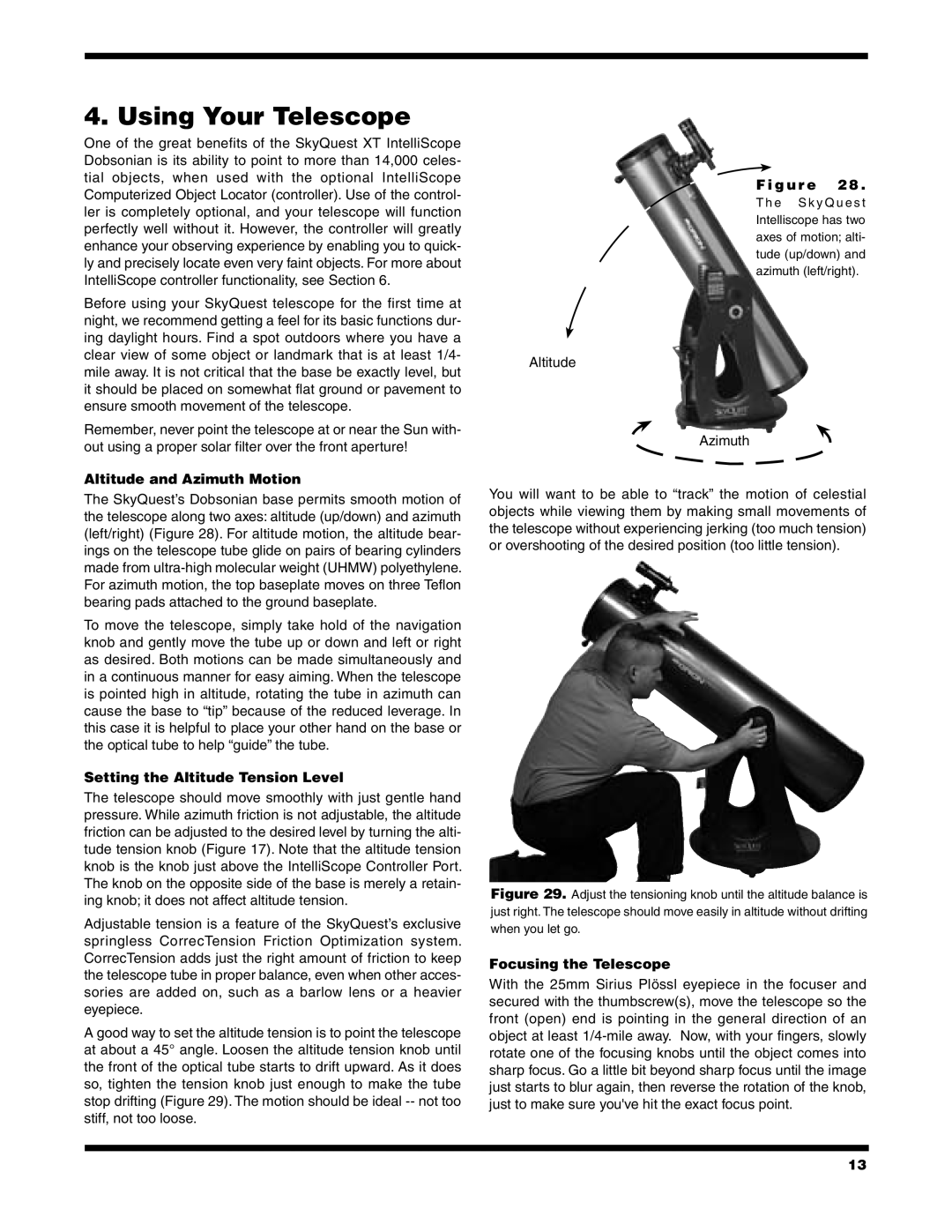
4. Using Your Telescope
One of the great benefits of the SkyQuest XT IntelliScope Dobsonian is its ability to point to more than 14,000 celes- tial objects, when used with the optional IntelliScope Computerized Object Locator (controller). Use of the control- ler is completely optional, and your telescope will function perfectly well without it. However, the controller will greatly enhance your observing experience by enabling you to quick- ly and precisely locate even very faint objects. For more about IntelliScope controller functionality, see Section 6.
Before using your SkyQuest telescope for the first time at night, we recommend getting a feel for its basic functions dur- ing daylight hours. Find a spot outdoors where you have a clear view of some object or landmark that is at least 1/4- mile away. It is not critical that the base be exactly level, but it should be placed on somewhat flat ground or pavement to ensure smooth movement of the telescope.
Remember, never point the telescope at or near the Sun with- out using a proper solar filter over the front aperture!
Altitude and Azimuth Motion
The SkyQuest’s Dobsonian base permits smooth motion of the telescope along two axes: altitude (up/down) and azimuth (left/right) (Figure 28). For altitude motion, the altitude bear- ings on the telescope tube glide on pairs of bearing cylinders made from
To move the telescope, simply take hold of the navigation knob and gently move the tube up or down and left or right as desired. Both motions can be made simultaneously and in a continuous manner for easy aiming. When the telescope is pointed high in altitude, rotating the tube in azimuth can cause the base to “tip” because of the reduced leverage. In this case it is helpful to place your other hand on the base or the optical tube to help “guide” the tube.
Setting the Altitude Tension Level
The telescope should move smoothly with just gentle hand pressure. While azimuth friction is not adjustable, the altitude friction can be adjusted to the desired level by turning the alti- tude tension knob (Figure 17). Note that the altitude tension knob is the knob just above the IntelliScope Controller Port. The knob on the opposite side of the base is merely a retain- ing knob; it does not affect altitude tension.
Adjustable tension is a feature of the SkyQuest’s exclusive springless CorrecTension Friction Optimization system. CorrecTension adds just the right amount of friction to keep the telescope tube in proper balance, even when other acces- sories are added on, such as a barlow lens or a heavier eyepiece.
A good way to set the altitude tension is to point the telescope at about a 45° angle. Loosen the altitude tension knob until the front of the optical tube starts to drift upward. As it does so, tighten the tension knob just enough to make the tube stop drifting (Figure 29). The motion should be ideal
F i g u re 2 8 .
T h e S k y Q u e s t Intelliscope has two axes of motion; alti- tude (up/down) and azimuth (left/right).
Altitude
Azimuth
You will want to be able to “track” the motion of celestial objects while viewing them by making small movements of the telescope without experiencing jerking (too much tension) or overshooting of the desired position (too little tension).
Figure 29. Adjust the tensioning knob until the altitude balance is just right. The telescope should move easily in altitude without drifting when you let go.
Focusing the Telescope
With the 25mm Sirius Plössl eyepiece in the focuser and secured with the thumbscrew(s), move the telescope so the front (open) end is pointing in the general direction of an object at least
13
